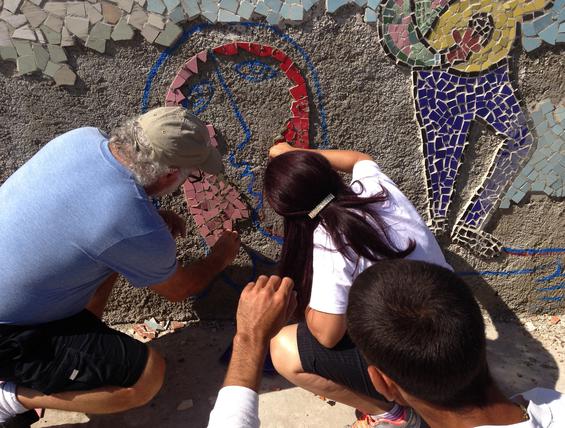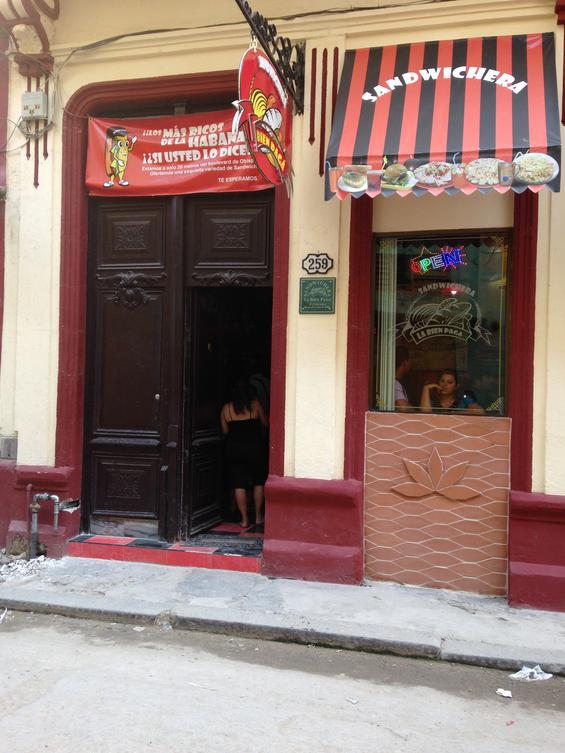Cuba is an opportunity to relive life as we enjoyed it in the 1950s. Being in that warm and friendly country is experiencing an environment held motionless in time for more than 50 years.
That does not mean that the country is not progressing, only that it had its more noticeable growth period in the years before 1959. The 2.1 million people who live in the capital city of La Habana, the official name of we call Havana, see infrastructure improvements constantly. The problem is that the improvements are constantly slow! To the 11 million residents of Cuba this is not an inconvenience, it is simply the way things are.
A recent Go Eat Give cultural mission to Havana, Cuba, provided an opportunity to meet and work with Cubans who were doing a variety of things to make their small island an appealing place to live.
We worked with farm workers, healthcare professionals and artists.
We found they were completely welcoming to Americans. Together we picked beans, worked on a public art mosaic wall drawn for us by an internationally-known artist, Jose Rodriguez Fuster, whose works have been exhibited in Cuba, England and France, and spent time serving an afternoon snack in a home for the elderly.
It was a revelation to learn that in Cuba, which mostly remains a mystery to our country, the literacy rate is 99.8 percent.
Even though our languages were different, we mostly could communicate with a few words and often our own brand of sign language that might result in hearty laughter. As we crossed the city many times, it was evident that this was very much a city of younger people with a median age of 39 years for men and 40 years for women with about 50 percent of the population being between 25 and 54 years of age.
Beyond the numbers, there is a youthful aura that permeates the Cuban culture. Live music everywhere. People walking briskly pursuing their everyday schedules. Wide smiles greeted us wherever we went. In some restaurants the musicians would choose one of our group and begin dancing among the tables. We soon felt more like one of the family than outsiders visiting a place that has been forbidden to us for decades.
Using the word ‘decades’ reminds me of the spectacular collection of American cars from the 1950s and older that truly adorn the streets. Chevrolets, Cadillacs, Plymouths and old Ford Fairlanes. They are all there looking bright and beautiful. Cheery Yellow, Soft Lavender, Fire Engine Red, Bright Blue, Kelly Green, Deep Purple. Shiny and in pristine condition. Many cars still running because the owners have found ingenious ways to replace parts or create parts to repair the automobiles of which they are so proud. Just being on the streets of Havana is like going to an antique car show!
We were told that crime is low in this quiet but busy country. They attribute much of that to the fact that the Mafia was banned from Cuba along with their gambling and casinos that flourished before the 1950s. Drug use is not prevalent and the HIV health problem affects only .1 percent of the population.
Architecture throughout the capital city is reminiscent of historic Europe. Lovely, gracious facades with graceful arches and molded friezes. The Cuban capitol looks like our capitol in Washington. Sculptures and historic statues are situated from large airy squares to small tree-lined parks. Some statues have traditions such as if you touch the man’s bronze beard and hold his bronze hand, your wish will come true. A few modern, less interesting buildings are found tucked in among all the antique structures. Their presence provides an attractive contrast.
The most outstanding modern building is the art museum that is exciting both inside and outside. It is a huge complex of several buildings that has an extensive collection of traditional, modern and art deco exhibits. The areas are open, well-lighted and broad enough to make the presentations professional and captivating.
As you exit the museum, directly across the street is the Museum of the Revolution that was originally the Presidential Palace. Behind it is a glass-enclosed building that displays Fidel’s yacht, Granma. This structure is surrounded by a park featuring military icons: tank, airplane, missile, truck, guns. It is a must to visit both. Not only for the information but for the contrast of two Cuban histories.
Which brings us to the Fidel Castro history. It was amazing to us that there is next to no symbols of their leader of more than half a century. I saw only one picture and one wall-size silhouette of him. His image does not appear in the hundreds of kiosks in the public craft market nor on colorful postcards. Quite the opposite of the handsome Che Guevara. His picture or likeness is everywhere from postcards to small prints to the entire wall of one of the larger mid-rise buildings next to Fidel’s image. The Cubans we met, with whom we had long conversations in English, said that they do not know where Fidel is and that he is rarely seen. He is simply part of their history.
Cuba, the mystery country, located so close to our Florida Keys, remains shadowed in our own United States embargo, but Cuba is there nonetheless. Their culture touches ours in many ways going back centuries. Our own vibrant Cuban neighborhoods have brought wonderful traditions, energies, music and food to our country. Our shared family values and hardworking populations are reflections of the other. We came away feeling enriched and content with our Cuban cultural mission experience.
~ By Barbara Rose, president of the consulting firm for non-profits, New Generation Partnerships Inc.. Ms Rose visited Cuba with Go Eat Give in November 2014. Her article also appeared in Global Atlanta.



